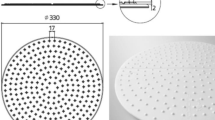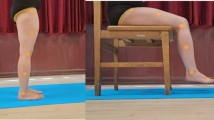Abstract
The purpose of this study was to investigate the effect of different types of mechanical stimulation of the sole on standing postural stability in healthy, young adults. Fifty subjects (34 women, 16 men; mean age 23 ± 2 (mean ± SE)) stood barefoot on fixed force plates both with open and closed eyes on firm surface and then on compliant surface (foam). A modified Clinical Test of Sensory Interaction on Balance protocol was employed to assess the center of gravity (COG) excursions along anteroposterior (AP) and mediolateral (ML) axes on each surface and visual condition. After the baseline measurement, a stimulation was applied with an elastic spiked layer topped to the firm and then foam surface, and the COG excursions were measured during the stimulation, and then at least 30 min after the stimulation of the spiked layer, we used 10 min of manual static and glide pressure applied to the plantar surface of both feet. Immediately after manual stimulation, static balance parameters were measured again. Results showed that after manual stimulation, the sway path with closed eyes decreased significantly on the AP and ML directions on firm surface conditions. The spiked layer caused significantly decreased sway path on firm platform in both directions, but it was ineffective on compliant surface. Our results established that the activation of plantar mechanoreceptors by 10-min manual stimulation can partially compensate subjects for the absence of visual input and the lack of accurate pressure information from the supporting surface, too.


Similar content being viewed by others
References
Bell-Krotoski JA, Fess EE, Figarola JH, Hiltz D (1995) Threshold detection and Semmes-Weinstein monofilaments. J Hand Ther 8:155–162
Bernard-Demanze L, Vuillerme N, Berger L, Rougier P (2006) Magnitude and duration of the effects of plantar sole massages on the upright stance control mechanism of healthy individuals. Int SportMed J 7:154–169
Bernard-Demanze L, Vuillerme N, Ferry M, Berger L (2009) Can tactile plantar stimulation improve postural control of persons with superficial plantar sensory deficit? Aging Clin Exp Res 21:62–68
Brandt T, Paulus W, Straube A (1986) Vision and posture. In: Bles W, Brandt T (eds) Disorders of posture and Gait. Elsevier, Amsterdam, pp 157–175
Dyck PJ, O’Brien PC, Kosanke JL, Gillen DA, Karnes JL (1993) A 4, 2, and 1 stepping algorithm for quick and accurate estimation of cutaneous sensation threshold. Neurology 43:1508–1512
Goldreich D, Kanics IM (2003) Tactile acuity is enhanced in blindness. J Neurosci 23:3438–3445
Hayashi R, Miyake A, Watanabe S (1988) The functional role of sensory inputs from the foot: stabilizing human standing posture during voluntary and vibration-induced body sway. Neurosci Res 5:203–213
Henry SM, Fung J, Horak FB (2001) Effect of stance width on multidirectional postural responses. J Neurophysiol 85:559–570
Horak FB, Nashner LM, Diener HC (1990) Postural strategies associated with somatosensory and vestibular loss. Exp Brain Res 82:167–177
Jeka JJ, Easton RD, Bentzen BL, Lackner JR (1996) Haptic cues for orientation and postural control in sighted and blind individuals. Percept Psychophys 58:409–423
Kavounoudias A, Roll R, Roll JP (1998) The plantar sole is a ‘dynamometric map’ for human balance control. Neuroreport 9:3247–3252
Lee DL, Lishman JR (1977) Vision, the most efficient source of proprioceptive information for balance control. Agressologie 18:83–94
Magnusson M, Enbom H, Johansson R, Pyykko I (1990) Significance of pressor input from the human feet in anterior-posterior postural control. The effect of hypothermia on vibration induced body sway. Acta Otolaryngol Stockh 110:182–188
Maki BE, McIlroy WE (1996) Postural control in the older adult. Clin Geriatr Med 12:635–658
Maki BE, McIlroy WE (1997) The role if limb movements in maintaining upright stance: the “change in support” strategy. Phys Ther 77:488–507
Maki BE, Perry SD, Norrie RG, McIlroy WE (1999) Effects of facilitation of sensation from plantar foot-surface boundaries on postural stabilization in young and older adults. J Gerontol A Biol Sci Med Sci 54:M281–M287
Maurer C, Mergner T, Bolha B, Hlavacka F (2001) Human balance control during cutaneous stimulation of the plantar soles. Neurosci Lett 302:45–48
Mauritz KH, Dietz V (1980) Characteristics of postural instability induced by ischemic blocking of leg afferents. Exp Brain Res 38:117–119
Meyer PF, Oddson LI, De Luca CJ (2004) The role of plantar cutaneous sensation in unpertubed stance. Exp Brain Res 156:505–512
Nagy E, Toth K, Janositz G, Kovacs G, Feher-Kiss A, Angyan L, Horvath G (2004) Postural control in athletes participating in an ironman triathlon. Eur J Appl Physiol 92:407–413
Nagy E, Feher-Kiss A, Barnai M, Preszner-Domján A, Angyan L, Horvath G (2007) Postural control in elderly subjects participating in balance training. Eur J Appl Physiol 100:97–104
Nashner LM (1982) Adaptation of human movement to altered environments. Trends Neurosci 5:351–361
Nashner LM, Black FO, Wall C (1982) Adaptation to altered support and visual conditions during stance: patients with vestibular deficits. J Neurosci 5:117–124
Nurse MA, Hulligar M, Wakeling JM, Nigg BM, Stefanyshyn DJ (2005) Changing the texture of footwear can alter gait patterns. J Electromyogr Kinesiol 15:496–506
Oie KS, Kiemel T, Jeka JJ (2002) Multisensory fusion: simultaneous re-weighing of vision and touch for the control of human posture. Cog Brain Res 14:154–176
Palluel E, Nougier V, Olivier I (2008) Do spike insoles enhance postural stability and plantar-surface cutaneous sensitivity in the elderly? Age 30:53–61
Palluel E, Nougier V, Olivier I (2009) The lasting effects of spike insoles on postural control in the elderly. Behav Neurosci 123:1141–1147
Priplata AA, Niemi JB, Harry JD, Lipsitz LA, Collins JJ (2003) Vibrating insoles and balance control in elderly people. Lancet 362:1123–1124
Shumway-Cook A, Horak FB (1986) Assessing the influence of sensory interaction on balance: suggestion from the field. Phys Ther 66:1548–1550
Stål F, Fransson PA, Magnusson M, Karlberg M (2003) Effects of hypothermic anesthesia of the feet on vibration-induced body sway and adaptation. J Vestib Res 13:39–52
Vaillant J, Vuillerme N, Janvey A, Louis F, Braujou R, Juvin R, Nougier V (2008) Effect of manipulation of the feet and ankles on postural control in elderly adults. Brain Res Bull 75:18–22
Vaillant J, Rouland A, Martigné P et al (2009) Massage and mobilization of the feet and ankles in elderly adults: effect on clinical balance performance. Man Ther 14:661–664
Vedel JP, Roll JP (1982) Response to pressure and vibration of slowly adapting cutaneous mechanoreceptors in the human foot. Neurosci Lett 34:289–294
Vuillerme N, Pinsault N (2007) Re-weighting of somatosensory inputs from the foot and the ankle for controlling posture during quiet standing following trunk extensor muscles fatigue. Exp Brain Res 183:323–327
Vuillerme N, Chenu O, Pinsault N, Fleury A, Demongeot J, Payan Y (2008) Can a plantar pressure-based tongue-placed electrotactile biofeedback improve postural control under altered vestibular and neck proprioceptive conditions? Neuroscience 155:291–296
Winter DA (1995) Human balance and posture control during standing and walking. Gait Posture 3:193–214
Winter D, Prince F, Stergiou P, Powel C (1993) Medial-lateral and anterior-posterior motor responses associated with center of pressure changes in quiet standing. Neurosci Res Comm 12:141–148
Winter DA, Prince F, Frank JS Powell C, Zabjek KF (1996) Unified theory regarding A/P and M/L balance in quiet stance. J Neurophysiol 75:2334–2343
Woollacott MH, Shumway-Cook A, Nashner L (1986) Aging and posture control: changes in sensory organization and muscular coordination. Int J Aging Hum Dev 23:97–114
Wu G, Chiang JH (1996) The effect of surface compliance on foot pressure in stance. Gait Posture 4:12–129
Acknowledgments
The authors are grateful to Cs. Keresztes for linguistic correction of the manuscript. The authors would like to thank all participants. We declare that the experiments reported in this paper fully comply with all the current Hungarian laws and regulations.
Conflict of interest
The authors declare that they have no conflict of interest.
Author information
Authors and Affiliations
Corresponding author
Additional information
Communicated by Dick F. Stegeman.
Rights and permissions
About this article
Cite this article
Preszner-Domjan, A., Nagy, E., Szíver, E. et al. When does mechanical plantar stimulation promote sensory re-weighing: standing on a firm or compliant surface?. Eur J Appl Physiol 112, 2979–2987 (2012). https://doi.org/10.1007/s00421-011-2277-5
Received:
Accepted:
Published:
Issue Date:
DOI: https://doi.org/10.1007/s00421-011-2277-5




